Aloe Vera plants have long been coveted for their medicinal properties, and are even listed as an active ingredient in many health, wellness, and beauty products. What makes this plant even more special is that it can be easily grown indoors, no matter what your previous gardening experience.
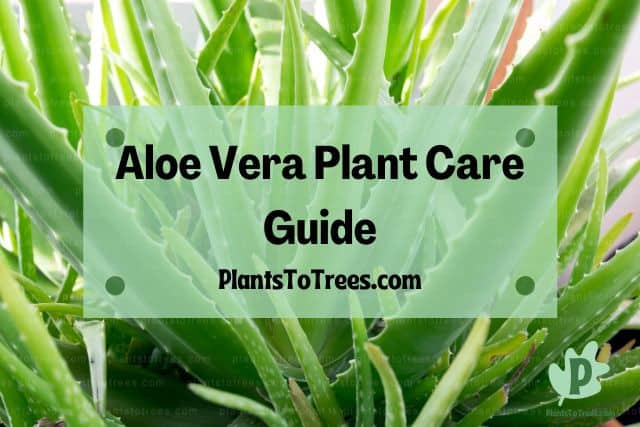
The Aloe vera plant care guide gives you a chance to familiarize yourself with the growing requirements for this succulent. All you need to do to succeed in growing this plant is to provide it with indirect sunlight, allow for the soil to dry out between waterings, and protect it from cold temps.
Aloe vera plants are one of the easiest, non-nonsense plants you can grow. Not only is it a wonderful plant for all gardening levels, but the gel that it naturally produces can help ease and heal burns and wounds.
People will often snap off a piece of their Aloe vera plant and rub the cool gel-like substance found inside the foliage on their skin. This is because the plant contains antibacterial and antioxidant properties. It can also help treat canker sores, improve the overall health of the skin, prevent wrinkles, and speed up wound healing.
Other Names Of Aloe Vera Plant
Most people are familiar with Aloe vera plants. Even if you don’t know how to grow or care for them, you are sure to have heard about this plant in some form or another. You may even know it by another name.
The Aloe vera plant is most well known by the name ‘Aloe vera’. It does, however, have a few different other monikers that people call it, including Aloe, barbados Aloe, babosa, and cape Aloe.
Frost Tolerance And USDA Hardiness Zone Of Aloe Vera Plant
If you’re considering growing the Aloe vera plant outdoors, you must first find out what this plant’s tolerance to cold and frost is, as well as what zones it can survive in when planted outside.
Aloe vera plants cannot withstand cold temperatures, nor is it frost tolerant. Although there are some alpine varieties that are a bit more cold tolerant, withstanding temps close to freezing. The majority of Aloe vera plants, however, grow outdoors in USDA hardiness zones 8 to 11.
Some indoor gardeners take their Aloe vera plants outside during warm weather, and it is not uncommon to see people with potted Aloe veras sitting on their front porch during the summer.
If you do decide to take your plant outdoors, just make sure that it isn’t in direct sunlight and is protected from heavy rain, winds, and hail. Furthermore, don’t forget to bring the plant back inside when the temperature starts to drop below 60 degrees.
How Many Hours Of Sunlight Does Aloe Vera Plant Need?
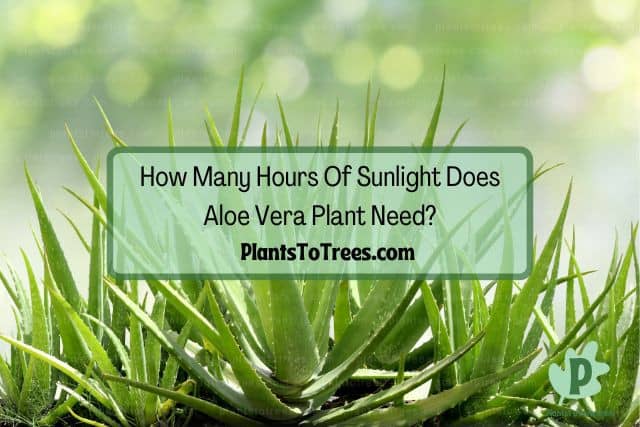
Even though the Aloe vera plant isn’t a picky houseplant, it does need sunlight to keep it healthy and thriving. But the question is, how many houses of sunlight does an Aloe vera plant need?
Aloe vera plants need at least 6 hours of sunlight every single day. If they don’t get this amount of light, the Aloe vera plant will start to stretch, become compact, and the stems will become weak. It is not uncommon for Aloe vera plants to fall over once their stems are weakened.
If you don’t have an area indoors where it can get at least 6 hours of light a day, consider using artificial light. While some believe sunlight is the best for indoor plants, most experts say that artificial lights work just as well. Just make sure that the artificial lights are not too close to the plant or it will cause leaf burn.
Aloe Vera Plant Needs Direct Or Indirect Sunlight?
Direct or indirect sunlight is a common question that indoor gardeners, especially those new to the whole process, often ask. After all, most people who don’t grow plants are not aware of the difference between the two.
Bright, indirect sunlight is the lighting requirement for Aloe vera plants. Allowing the plant to grow in direct light will cause its leaves to dry out, turning them yellow and unattractive. Plants that are grown in direct light will also require more water.
Is Aloe Vera Plant An Indoor Plant, Outdoor Plant Or Both?
Whether or not the Aloe vera plant is an indoor or outdoor plant will depend on the area where you live. Like all other plants, there are certain climates where the Aloe vera can grow safely outside. However, since this plant is tropical, they cannot tolerate cold temps very well, nor can they survive frost.
In USDA hardiness zones 8 to 10, the Aloe vera plant can happily grow outdoors. But because it isn’t cold hardy and cannot handle freezing temperatures, this plant can only grow as a houseplant in colder areas. It is not uncommon for people to move their Aloe vera outside during the summer months.
What Are The Indoor Lighting Requirements For An Aloe Vera Plant?
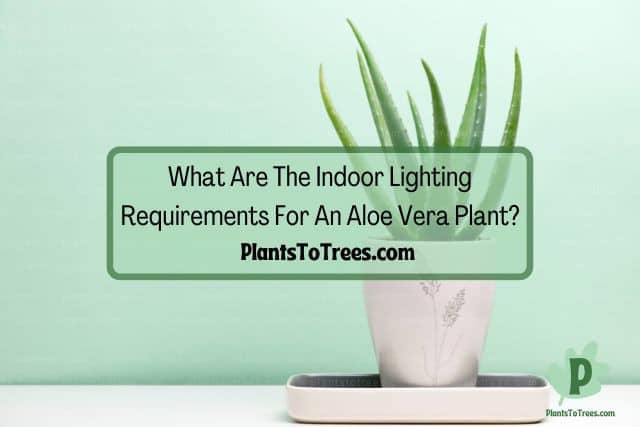
Indoor houseplants have a bit of advantage over outdoor plants when it comes to lighting. This is because you can control the amount of light the plant gets by either moving it to a shaded area or using artificial options to increase the light.
Select a spot where your indoor Aloe vera plant will get at least 6 hours of bright, indirect sunlight. A southern-facing or western-facing window works well to give the plant adequate light. If there is too much shade, the Aloe vera will become leggy and compact.
Remember that even if you cannot provide the recommended amount of sunlight every day, your Aloe vera plant can still survive. It just may not grow as quickly as one that is growing in the optimal lighting conditions.
What Are The Outdoor Lighting Requirements For An Aloe Vera Plant?
Whether it is grown indoors or outdoors, Aloe vera plants need the same amount and type of lighting for optimal growth.
If grown outdoors, the Aloe vera will need 6 to 8 hours of sun, preferably a west or south-facing area where it gets direct sunlight. Select a site where the ground is sandy, or even rocky or gravelly. Aloe vera doesn’t do well in soggy soils, so avoid planting them in an area where the water pools.
If you’re unsure as to whether or not you live in a climate where Aloe vera can grow outdoors, check with the USDA plant hardiness zone website. Simply enter in your zipcode to determine your zone. Another option is to speak to your local nursery or greenhouse as they will be able to provide you with this information.
What Soil Requirements Does Aloe Vera Plant Need?
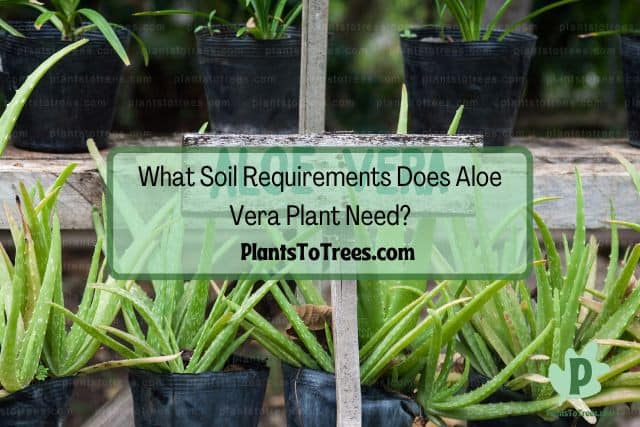
Because the Aloe vera plant is a succulent, it will need soil that allows for water to drain freely through it. Thankfully, there are various soil mixes available online and in stores that work perfectly for Aloe vera plants.
Like other succulents, Aloe vera plants need soil that drains well. Avoid using traditional gardening soil and instead use potting mixes made for succulents and cacti. The ideal mix will contain lava rock, perlite, chunks of bark, or a mixture of the three.
Avoid soils that are compact as these will only increase the chance of overwatering the Aloe vera plant. If you have difficulty finding the right soil mix, speak to an associate at your local nursery. They are more than happy to assist you in locating the right soil mix for your succulent.
How Much Water Does Aloe Vera Plant Need?
Aloe vera plants are not heavy drinkers and can benefit from allowing the soil to dry out a bit between waterings.
While the exact time frame for when you should water the Aloe vera plant will vary, a good general rule of thumb is to water once every 3 weeks. When it is time to water, do so deeply. The goal is to give the Aloe vera plant’s soil a good soak infrequently.
For watering the plant, make sure to insert your finger 1 to 2 inches into the soil. If it feels dry, it’s time to water the Aloe vera. If the soil still feels moist, wait a few days and then test the soil moisture level again.
Is My Aloe Vera Plant Overwatered, What Are The Symptoms?
Overwatering your Aloe vera can be a serious problem, especially if it occurs multiple times. Overwatering leads to root rot, which can actually kill the plant. Thankfully, overwatering an Aloe vera plant is 100-percent preventable.
Leaves that start to turn yellow or brown are the most common symptom of an overwatered Aloe vera plant. These leaves will then start to have a mushy texture and wilt. As root rot takes hold, the Aloe vera’s roots will start to brown and die, and you may even begin to smell a moldy or rotting odor.
If you do have an overwatered Aloe vera plant, you can try to save it by removing the plant from its pot and getting rid of all the soil. This includes the soil that is intertwined with the roots. Once all the soggy soil has been removed, repot the Aloe vera plant in a container with fresh soil.
Is My Aloe Vera Plant Underwatered, What Are The Symptoms?

Underwatered an Aloe vera plant can be easily done, especially when you consider just how little water this plant needs. The good news is that, in most cases, an underwatered Aloe vera plant can be revived rather easily and bounces back quickly.
When the Aloe vera plant is underwatered, its leaves will start to curl and droop, and the potting soil will feel extremely dry and crumbly. You may also notice the leaves have brown tips and are turning yellow.
If you have underwatered the Aloe vera plant for some time, you will need to carefully remove the plant from its pot and submerge its roots in lukewarm water for about 48 hours. After the allotted time has passed, replant the Aloe vera in potting mix designed for succulents and cacti.
How Much Fertilizer Does Aloe Vera Plant Need?

While not a requirement, fertilizing your houseplants can help boost their growth and keep the plant healthy. If you are growing an Aloe vera plant, consider feeding it every so often.
Aloe vera plants grown in a pot will need to be fertilized once a month using a 10-40-10 liquid fertilizer. You can also use fertilizer designed for succulents instead. For Aloe vera plants growing outdoors in the ground, fertilizing once in the spring is all that is needed.
As with any fertilizer, follow the application instructions located on the back of the bottle. This will help ensure you don’t over fertilize the plant, which can seriously harm the plant and even kill it. It is better to apply no fertilizer to the Aloe vera than to give it too much. An Aloe vera plant that isn’t fed will still survive, but one that is fed too much can have serious problems and even die from over-fertilization.
Aloe Vera Plant Diseases To Be Aware Of

The Aloe vera plant is a relatively easy plant to care for, and doesn’t require an abundance of special treatment. Unfortunately, this plant can come under attack from a few different diseases, some of which can be serious.
Aloe vera plants can develop a wide array of diseases, but the most common are stem rot, Aloe rust, soft rot, root rot, and anthracnose disease. Thankfully, most of the diseases affecting Aloe vera plants are easily preventable.
Stem rot is caused by a fungus and is, unfortunately, fatal to Aloe vera plants. This disease is favorable in cold and damp conditions. It will cause the infected plant to develop red or brownish black areas at the base of the plant. These areas will start to rot and eventually kill the plant.
Aloe rust is another common fungal disease that is most prevalent in conditions with high humidity levels and cool temperatures. It causes small yellowish spots to form on the plant’s foliage. These spots will expand and darken to a brownish color. You may also see orange-colored spores clustered together on the underside of the foliage. Affected leaves will also drop off the Aloe vera. Thankfully, this disease is considered self-limiting and doesn’t require any treatment.
Soft rot is caused by a bacteria that thrives in hot, wet conditions. This bacteria hides in plant debris and is fatal to Aloe vera. Affected plants will start to develop watery leaves that start to rot. Leaves can also wilt and even bulge out a bit due to gas forming inside.
Root rot is one of the most well-known fungal diseases that can infect just about any plant. This disease is caused by overwatering or soil without good drainage. Infected plants can start to develop water-filled blisters on their leaves and stems, and the plant will begin to wilt and collapse. Root rot is difficult to get rid of and, even in the early stages of the disease, typically fatal.
Anthracnose disease is a fungal disease that thrives in wet, warm conditions, and spreads when water splashes. It causes small oval or round water-soaked blisters to form on the plant. At the center of these blisters is a light brown or even tan color that will darken to a reddish brown as time passes. As anthracnose disease starts to progress, the center of the blisters will spread and join together, which forms a large necrotic area. Thankfully, this disease can be treated with fungicide.
No matter what the disease is, the best way to help your Aloe vera plant fight off diseases and pests is to ensure the plant is strong and healthy. A strong and healthy Aloe vera is more likely to overcome problems and snap back quicker than a plant that is weakened or sickly.
In addition, if your Aloe vera does develop a disease, consider quarantining the plant in another room away from your other houseplants. This will help prevent the spread of disease or pests, and keep your remaining houseplants safe.
Are There Different Types Of Aloe Vera Plants?
While most Aloe vera plants have a similar appearance, they are not all made the same. Some have different colored leaves, while others are smaller or taller in size.
There are over 500 species of Aloe vera plant, and most of them have the same, or similar, growing requirements. One of the easiest ways to differentiate between the various Aloe vera plants is the shape, color, texture, and size of the foliage.
One of the most popular Aloe vera varieties is Aloe Barbadensis Miller. This Aloe vera plant is edible and is grown for its healing properties. The foliage of this plant is vibrant green with white spots that start to disappear as the plant ages.
Aloe ‘Crosby’s Prolific’ is a dwarf Aloe and its small stature makes it ideal for indoor gardeners who have limited space.
We at Plants To Trees first published this article on October 27, 2022. Copyright protected.
For gardeners in the right climate, the Aloe Cameronii makes a stunning addition to garden beds. It produces reddish copper leaves and reddish orange flowers.
How To Propagate Aloe Vera Plant
Propagating Aloe vera plants is an easy and inexpensive way to double the amount of plants you have. It can also help keep the size of your plant in check.
Aloe vera can be propagated using multiple methods, including from seed or leaf cutting. The easiest and fastest propagated method, however, is to take an offshoot from the parent plant. Offshoots are baby Aloe plants that form at the base of the parent plant.
The best time to propagate Aloe vera is during its active growing season, which is in late spring to early summer. So keep this in mind and plan accordingly.
To propagate using offshoots, you will first need to remove the entire plant from the pot and then use your fingers to gently remove all the potting soil. Carefully divide the offshoots, which should have their own root systems, from the parent plant. You may have to gently untangled the offshoot’s roots from the parent plant.
Once the offshoots have been removed, allow the parent plant and the babies to heal before replanting them. This requires leaving the parent plant and offshoots out of the soil for about 24 hours. Make sure to place them in an area that is dry and warm where they won’t be disturbed. When a healthy Aloe plant is wounded, it will create calluses over the area to help speed up its recovery.
After the 24 hours have passed, replant the parent Aloe vera into its pot and plant the baby Aloe vera into its new pot. Continue to care for the parent plant as you normally would, but wait one to two weeks after planting the baby Aloe before watering it.
Is an Aloe Vera Plant Toxic To Humans?
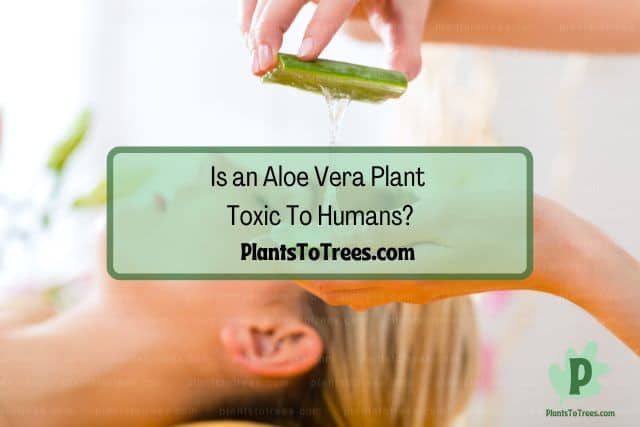
Even if you don’t plan on eating the Aloe vera plant for dinner, it is a good idea to understand the toxicity level of this plant and whether or not it poses a risk to humans.
Aloe vera plants are considered mildly toxic to humans, and can cause diarrhea if consumed. Thankfully, most symptoms pass within a day or two and treatment typically isn’t required. Some people, however, are allergic to Aloe, and for those individuals, Aloe vera can be dangerous.
There are some Aloe vera plants that are edible, but most people do not grow this kind in their home.
The article owner is Plants To Trees dot Com and this article was first published on October 27, 2022.
Is an Aloe Vera Plant Toxic To Dogs?
If you have a dog in your home, making sure you only grow safe and non-toxic plants is one of the best ways to protect them from potential poisoning.
Aloe vera is toxic to dogs, and can cause mild to moderate symptoms. Diarrhea, vomiting, low blood sugar, loss of energy, and tremors can occur when a dog consumes an Aloe vera plant. In extreme cases, the Aloe vera plant can cause a breakdown of your dog’s red blood cells, which can be fatal.
With that said, however, rubbing Aloe vera gel onto your dog’s skin isn’t harmful. There are even several topical creams, lotions, and shampoos designed for dogs that contain Aloe vera. If you do use any of these products on your pooch, make sure they do not lick or ingest it.
Is an Aloe Vera Plant Toxic To Cats?
Cat owners should take it upon themselves to learn whether or not the Aloe vera plant is toxic to their feline friends before ever bringing the plant indoors. Far too often, cats are poisoned by popular houseplants because their humans were not aware of the dangers that some plants can cause. But are Aloe vera plants toxic to cats?
Aloe vera plants are toxic to cats and you should take great care not to allow your kitty to consume any part of this plant. If they do, they can suffer from stomach cramps, vomiting, and diarrhea. Consuming an excessive amount can result in severe dehydration, which can be life-threatening.
If you suspect your cat has chewed or ingested any part of an Aloe vera plant, immediately seek medical attention for your feline. In extreme cases, Aloe vera can cause irreversible and potentially deadly damage to their kidneys and liver.
Related Articles
African Violet Plant Care Guide
Tips On Caring For African Violet Flowers
Problems With African Violet Leaves (How to Fix)
PlantsToTrees.com is the owner of this article and we first published this on October 27, 2022.
